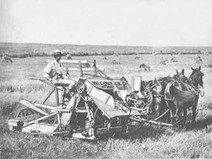 McCormick's Reaper, Circa 1850
McCormick's Reaper, Circa 1850 Now back to raw agricultural history, we have Cyrus McCormick’s grain reaper. Previous to this invention, wheat, barley, and other grains were cut, threshed (removal of non-usable parts), and bundled by hand. McCormick’s reaper, when pulled by a horse, cut, threshed, and bundled wheat, doing in 2 hours what previously took 3 men to do in a day.
McCormick’s greatest achievement however, spawned from his success with this machine. McCormick saw the opportunity provided by new transportation methods, such as railroads, steamboats, and canals, to be able to sell his product to farmers in both the East and the West. Previously, farmers made their own tools, or only had access to locally made tools, this was a major factor in keeping widespread agricultural technology in the dark ages, as they say. McCormick saw how transportation could spread new technologies, such as his reaper, to farmers around the country. And this is exactly what he did. The massive spike in agricultural technology in the past two centuries, spawned from transportation. McCormick’s reaper gave him the opportunity to kick start nationwide agribusiness, helping to move agriculture forward.
Sources:
1. http://www.agclassroom.org/gan/timeline/1820.htm
2. http://www.lib.niu.edu/1992/ihy921205.html
McCormick’s greatest achievement however, spawned from his success with this machine. McCormick saw the opportunity provided by new transportation methods, such as railroads, steamboats, and canals, to be able to sell his product to farmers in both the East and the West. Previously, farmers made their own tools, or only had access to locally made tools, this was a major factor in keeping widespread agricultural technology in the dark ages, as they say. McCormick saw how transportation could spread new technologies, such as his reaper, to farmers around the country. And this is exactly what he did. The massive spike in agricultural technology in the past two centuries, spawned from transportation. McCormick’s reaper gave him the opportunity to kick start nationwide agribusiness, helping to move agriculture forward.
Sources:
1. http://www.agclassroom.org/gan/timeline/1820.htm
2. http://www.lib.niu.edu/1992/ihy921205.html
 RSS Feed
RSS Feed